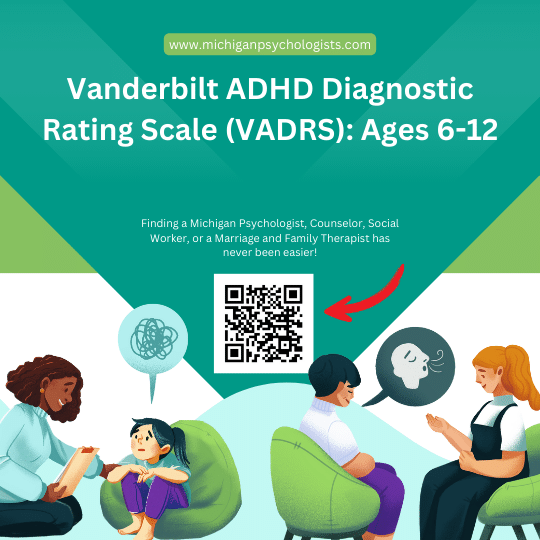Vanderbilt ADHD Diagnostic Rating Scale (VADRS): Ages 6-12
Home » Psychological Tests » ADHD Tests and Screeners » Vanderbilt ADHD Diagnostic Rating Scale (VADRS): Ages 6-12
Table of Contents
Attention-Deficit/Hyperactivity Disorder (ADHD) is one of the most common neurodevelopmental disorders diagnosed in childhood. It affects millions of children worldwide, often continuing into adulthood. Diagnosing ADHD accurately and early can significantly impact a child’s academic performance, social interactions, and overall well-being. One of the most reliable tools used in the diagnosis process is the Vanderbilt ADHD Diagnostic Rating Scale (VADRS), specifically designed for children aged 6-12. This article aims to provide a comprehensive overview of the VADRS, its purpose, usage, scoring, accuracy, and common questions about its implementation.
What is the Vanderbilt ADHD Diagnostic Rating Scale (VADRS)?
The Vanderbilt ADHD Diagnostic Rating Scale (VADRS) is a standardized tool used to evaluate the presence and severity of ADHD symptoms in children aged 6 to 12. Developed by the Vanderbilt University Medical Center, this scale is widely used by healthcare professionals, including pediatricians, psychiatrists, and psychologists, to gather information from both parents and teachers about a child’s behavior and performance in various settings.
Purpose of the VADRS
The primary purpose of the VADRS is to assist in the diagnosis of ADHD by providing a structured method for collecting observational data on a child’s behavior. It helps to identify:
- Symptoms of inattention.
- Symptoms of hyperactivity and impulsivity.
- Performance issues in academic and social settings.
- Comorbid conditions such as Oppositional Defiant Disorder (ODD), Conduct Disorder (CD), and Anxiety.
How the VADRS is Used
The VADRS consists of two forms: one for parents and one for teachers. Each form includes a series of questions grouped into categories related to the core symptoms of ADHD and other behavioral issues.
- Parent Form: This form is filled out by the child’s primary caregivers. It includes questions about the child’s behavior at home and in social settings outside of school.
- Teacher Form: This form is filled out by the child’s teachers. It focuses on the child’s behavior and performance in the classroom and during other school-related activities.
Both forms use a Likert scale where respondents rate the frequency of specific behaviors on a scale from 0 (never) to 3 (very often).
How the VADRS is Scored
Scoring the VADRS involves summing the responses in each category to determine the severity of symptoms. The key areas evaluated are:
- Inattention: Items 1-9 on the parent and teacher forms.
- Hyperactivity/Impulsivity: Items 10-18 on the parent and teacher forms.
- Performance: Items 36-43 on the parent form and items 29-35 on the teacher form.
Additionally, there are items related to ODD, CD, and Anxiety that help identify comorbid conditions.
- Symptom Scores: The total score for each symptom category is calculated by adding the scores of relevant items. A higher score indicates more severe symptoms.
- Performance Scores: These are evaluated based on the child’s performance in different settings, such as academic achievement and social interactions.
The Accuracy of the VADRS
The VADRS is considered a highly reliable and valid tool for screening and diagnosing ADHD. Studies have shown that it has strong psychometric properties, including high internal consistency and good test-retest reliability. However, it is important to note that the VADRS should not be used as the sole diagnostic tool. It is most effective when used as part of a comprehensive assessment that includes clinical interviews, direct observation, and other standardized tests.
Frequently Asked Questions on the VADRS
1. What age group is the VADRS designed for?
The VADRS is designed for children aged 6-12 years.
2. Who can administer the VADRS?
The VADRS can be administered by healthcare professionals such as pediatricians, psychiatrists, psychologists, and school counselors.
3. How long does it take to complete the VADRS?
Each form (parent and teacher) typically takes about 10-15 minutes to complete.
4. Can the VADRS diagnose ADHD on its own?
No, the VADRS is a screening tool and should be used as part of a comprehensive assessment that includes clinical interviews and other diagnostic measures.
5. What is the scoring threshold for diagnosing ADHD?
The scoring threshold varies, but generally, a higher total score in the symptom categories suggests a greater likelihood of ADHD. Clinical judgment is crucial in interpreting the scores.
6. Are there any cultural considerations when using the VADRS?
Yes, cultural and linguistic factors should be considered as they can influence the interpretation of behaviors and responses.
7. Can the VADRS be used to monitor treatment progress?
Yes, the VADRS can be used periodically to monitor changes in symptoms and the effectiveness of treatment interventions.
8. What should be done if there is a discrepancy between parent and teacher ratings?
Discrepancies should be explored through further assessment and discussions with both the parents and teachers to understand the context of the ratings.
9. Are there any limitations to the VADRS?
While the VADRS is a valuable tool, it relies on subjective reporting and may be influenced by biases. It should be used in conjunction with other diagnostic tools.
10. Where can I find the VADRS forms?
The VADRS forms are available through various medical and psychological assessment resources and can often be obtained directly from healthcare providers or educational institutions.
The Vanderbilt ADHD Diagnostic Rating Scale (VADRS) is a crucial tool in the assessment and diagnosis of ADHD in children aged 6-12. It provides valuable insights into a child’s behavior across different settings, helping to identify symptoms and guide treatment planning. While it is a reliable and valid instrument, it should always be used as part of a comprehensive diagnostic process to ensure accurate and effective identification and management of ADHD.
